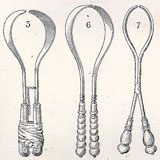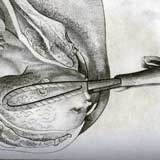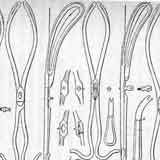“He’s a little old man very pale of complexion / Into many things makes a narrow inspection / His head’s very long and his hand’s very small” are the mysterious lines that open an anonymous 17th century English poem.1 Often presumed to refer to Hugh Chamberlen the Elder—the last of the famous Huguenot immigrant family of male midwives who hid the forceps as a family secret for over 100 years—the line could have equally alluded to the mysterious instrument, featured in the following gallery.1 Despite the efforts of this famous family, the forceps evolved over 200 years before other technologies made them more or less obsolete.
Click on any image to enter the gallery.




Attributed to the early 17th century London barber-surgeon and midwife, Peter Chamberlen the Elder, the invention permitted the accoucheur, or male midwife, to deliver a living child during obstructed labor. Previous obstetrical instruments, such as the perforator and crochet, were designed to expedite the removal of a dead or dying fetus in order to save the mother’s life.2,3 The emergence of the forceps fortuitously coincided with an epidemic of rickets in England, which placed women at risk of dystocia related to pelvic deformity.4



Peter the Elder and his brother Peter the Younger were astute businessmen who actively and secretively cultivated their private practice, to the ire of the College of Physicians and the dismay of women whose midwives did not have access to the device.1,4 The two Chamberlen men went to great lengths to maintain the secret to their successful midwifery practice: carrying the instrument in a large wooden box with guilded carvings, blindfolding the laboring woman, and permitting no one to enter the locked room where they performed their work.1,4



Around 1700, it was midwife Hugh the Elder, the son of accoucheur Peter III (Peter the Younger’s son), who unsuccessfully attempted to sell the family secret to famous French physician and rival, François Mauriceau.1,4 While the original Chamberlen instruments languished under the floorboards of the attic of Peter III’s home until approximately 1813, the family secret trickled out nonetheless, with versions of the forceps emerging in both France and England at the beginning of the early 18th century.1,4
As forceps emerged across Europe in the early 1700s, an ideal model or standards for use remained a distant prospect. It was William Smellie (1697-1763), the famous British obstetrician, who pioneered the evolution and proper use of the instrument in England, the information for which he readily disseminated in lectures and publications.3 Smellie constructed his forceps from wood or steel, covered the fenestrated blades in leather and hog’s lard, and connected them with an English lock, which other unwieldy devices of the time frequently lacked (See Palfyn’s mains de fer).3 His subsequent versions of the forceps were longer, providing a pelvic curve based on scientific study of pelvic measurements, which resulted in better application and reduced trauma to the perineum.3
At the same time that Smellie’s forceps emerged on the scene in Britain, André Levret’s forceps—which, also exhibiting a lock and pelvic curve, were longer, heavier, and differing in curvature—revolutionized obstetrics on the continent.3 Successive British forceps largely emulated Smellie’s design while subsequent incarnations of the forceps in continental Europe and elsewhere frequently emulated Levret’s design.3 Traction, axis-traction, and more complex devices appeared in the mid-to-late 19th century to address the issue of perineal trauma from poor directional control over the instrument—especially earlier in the second stage of labor—but even these had drawbacks since they were expensive and difficult to manufacture and assemble.3
Improvements to articulation, such as the lateral mortise, aided stability and ease of use while pressure-regulating handles prevented over-compression of the fetal head.3 The emergence of heat sterilization as a common practice led to the exclusive use of metal forceps, whose designs were lightened and strengthened with the development of carbon and stainless steel.3 However, despite important advancements in the technology, forceps were plagued by over- and improper use. Some influential obstetricians’ noted that the device caused at least as many issues as it resolved. Forceps use involved perineal trauma which, through overuse, could have contributed to unnecessary childbirth-related infection and hemorrhage, both major causes of post-partum mortality. Jean Louis Baudelocque (1746-1810), surgeon-in-chief and accoucheur at Paris Maternité, and one of the strongest advocates for use of the forceps during his lifetime, once said:
If it should be proved, and I am not very far from believing it, that the forceps have been more fatal than useful to society, that they have destroyed more than they have saved from inevitable death, I should nevertheless look upon them as the most important discovery that has ever been made in the art of midwifery.3
The beginning of the 20th century saw advancement in the Cesarean section, which made the use of forceps in the earlier portions of the second stage of labor obsolete, calling for a return to shorter, simpler forms of the forceps, with modifications to protect the head of the infant.5 With the rise of the Cesarean section and the development of the ventouse—a vacuum device that assists with the extraction of the infant during prolonged labor—forceps have consequently diminished in use.5 However, for two hundred years, they were the best, if also imperfect, hope of many women and infants, faced with the prospect of prolonged, difficult, and obstructed labor.
References
- Moore, W. (2007). Keeping mum. British Medical Journal, 334, 698. doi: 10.1136/bmj.39157.514815.47
- Savona-Ventura. (2007). Obstetric instrumental aids for delivery. Retrieved from http://staff.um.edu.mt/csav1/sho_course/8.pdf.
- Hibbard, B. (2000). The obstetrician’s armamentarium: Historic obstetric instruments and their inventors. Novato, CA: Norman Publishing. (Norman OB/GYN Series, No. 4)
- Dunn, P. (1999). The Chamberlen family (1560-1728) and obstetric forceps. Archives of Disease in Childhood: Fetal and Neonatal Edition, 81, F232-F235. Retrieved from http://www.ncbi.nlm.nih.gov.
SARA BUCK, Staff writer, Hektoen International
Highlighted in Frontispiece Fall 2012 – Volume 4, Issue 4

Leave a Reply